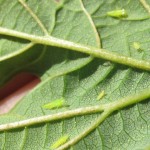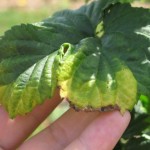
It is leafhopper season again and those pesky insects have been spotted at our research hopyard at Borderview Research Farm, in Alburgh, Vermont. This is a great time to start scouting for insects as well as for disease to ensure proper management of all hop pests. So far, this season has not been conducive for the hop pests that thrive in wet conditions, such as downy mildew and aphids, but the potato leafhoppers have arrived right on schedule. Potato leafhoppers are migratory insects transported via wind currents from the southern United States, generally appearing in the Northeast between late-May and mid-June. Our first sighting was on June 2, 2016.
To scout for potato leafhoppers, examine the back of a hop leaf for little torpedo shaped insects with distinctive green coloration. Young potato leaphoppers, or nymphs, are flightless insects and can be seen scuttling around the leaves in a side-to-side fashion. Adults can also be scouted by checking the backs of the leaves, or for a easier approach, you can just give your plants a little shake and watched the adult potato leafhoppers fly off the plant or jump from leaf to leaf. At our hopyard, we have only observed adults so far, but that means the nymphs aren’t far behind. Within one season, there are usually two or three generations of leaphoppers present in northern hop yards.

Potato leafhoppers are an economically damaging pest that can cause hopper burn, which is a distinctive yellowing of the leaves in a V-shaped pattern, eventually leading to leaf tip necrosis. Hopper burn decreases leaf photosynthetic activity and can cause plant production to suffer.
One of the best ways to combat potato leafhopper damage is by planting an alfalfa or red clover trap crop. Potato leafhoppers prefer to feed on these legumes and can be redirected from your hop yard with strategic plantings on the outskirts of the yard or in the drive row.
Stay vigilant and keep scouting!